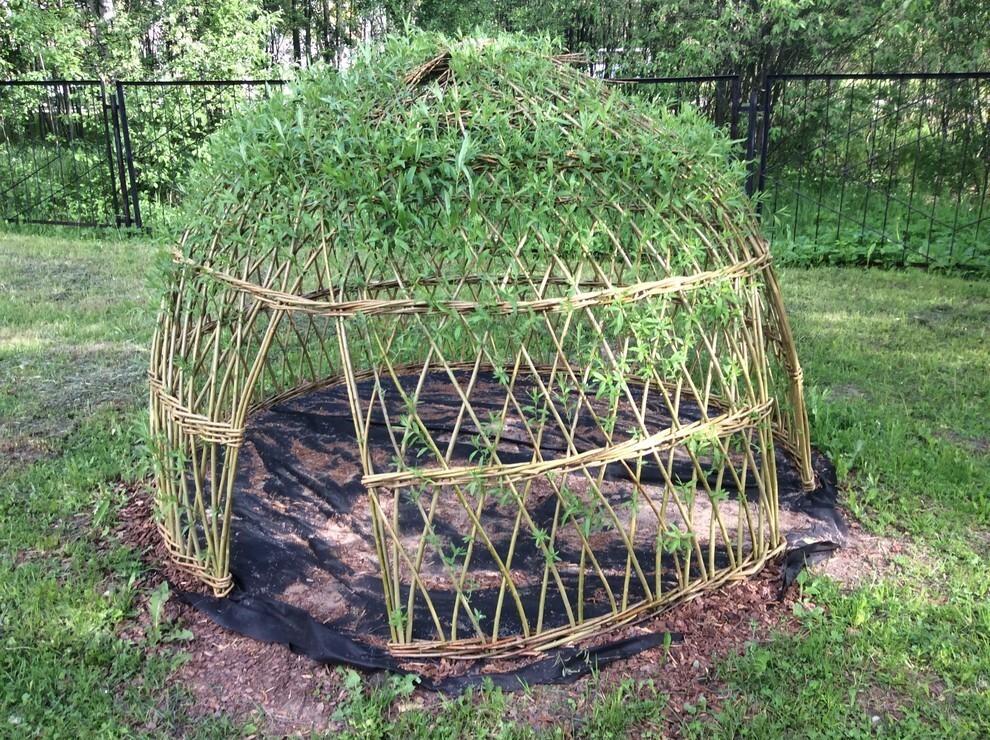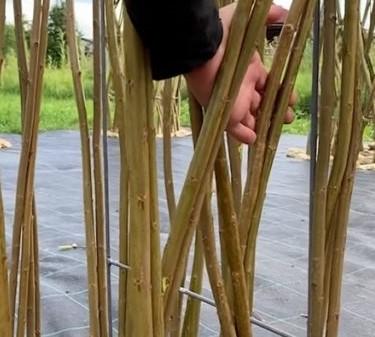Content
A willow gazebo on a summer cottage is the dream of many summer residents. In such a place you can organize a relaxation area to spend time reading or just breathing fresh air. The structure is easy to build yourself; it does not require any special skills. If you follow the instructions, the owner will be able to assemble his own gazebo in a short time.
Advantages and disadvantages
The construction of a capital structure made of willow, of course, requires a carefully prepared foundation, in some cases even a foundation.

The gazebo will not be able to protect a person from drafts or rain
All this could be considered a disadvantage if a person lived inside the structure. But this is not what this building is intended for. Despite the above, a garden structure made from living willow has advantages:
- The gazebo is an environmentally friendly structure that purifies the air and releases a pleasant aroma into the environment.
- You can always find a suitable place for a compact structure, plus it is not necessary to prepare a foundation for it.
- The construction is easy to do yourself, using willow branches that litter the coastlines in abundance. Fastenings are usually made with additional materials, but welding or carpentry skills are not needed here.
- The project can be drawn without any help, the main thing is that the willow gazebo matches the surrounding space.
- If the walls are of sufficient height, the visitor will be able to hide from the scorching sun and spend time in comfort. Usually they provide space for 3-6 people - for all family members.
- To build a full-fledged willow gazebo, you don’t need to think about expenses. Money will only be needed to purchase seedlings for the frame of the gazebo, and even then - not always.
- The owner can decorate the structure with additional plants and decorative elements. Often the roof is made from flowering crops, placing them in the form of a dome.
DIY gazebo made from willow branches
The process of creating a gazebo from living willow involves preparatory procedures. Once the owner chooses a location, the area is dug up and drainage material is added.

To limit the growth of the willow, you will also need a film - as a rule, it is enough to restrain young shoots
The next step is cutting the rods. They must be long enough to cover the roof with material. The minimum shoot thickness is 20 mm. There are several requirements for branches: absence of signs of disease and stains, flexibility, strength.
How to make a gazebo from live willow with your own hands
Building a willow gazebo is easier than it seems. To begin with, you can test your strength on a small project, if the result is positive, next time you can implement something more complex.The creation process is carried out in stages: first of all, it is the selection and preparation of the frame, then they begin to plant the seedlings.
Creating a wireframe
Like any other structure, a willow gazebo needs a frame, which will serve as thick rods. Construction instructions:
- Willow branches are attached to thinner twigs using twine, the thickest sections are left on top to create a dome.
- The shoots are tied while they are still fresh. When the material is completely dry, you will get a strong frame.
Willow planting
The last stage is the planting of green spaces, which will subsequently give shape to the assembled structure. The algorithm of actions is simple: first you need to prepare the branches - 300x2 cm. If they were cut a long time ago, the shoots are renewed by cutting the branches at the bottom (the optimal length of the segment is 5 cm).
Instructions for planting seedlings:
- If the frame consists of columns standing next to each other, the branches are buried 30 cm into the ground on each side - 2 pieces. After organizing the corner, four shoots are placed next to it, then four more in small increments.
- You should weave starting from the middle part. To do this, use the right rods and bend them. A similar procedure is done with other shoots - you should get two pores of bent branches, which the owner will hold with his hand.
- After this, they take the two distant rods, bend them over the already bent branches and get a pattern. To secure the willow shoots, you will need twine. After this, they move to the next side of the gazebo and do the same. The weave should resemble a diamond.
- Once all parties are ready, begin organizing the top row. When weaving, do not forget to use twine. After creating the arbor, the temporary gear is removed, by which time the vine should get used to the established
- Using a knife or pruning shears - always sharp and sterilized - cut off the tops of the branches so that 15-cm sections remain above the frame. The ends of the columns are created in a similar way.
Caring for a living willow gazebo
A willow gazebo will delight the owner only if he remembers to take care of it. Since the building is “living”, its growth needs to be controlled. From time to time, pruning is carried out - dry and damaged branches are removed, which make the gazebo untidy. It is better to carry out a haircut in accordance with the form provided by the project.
Immediately after planting, willow needs abundant watering. While the plant is young, moisturizing is done regularly. Subsequently, it will require less moisture. To prevent water from stagnating, a drainage layer is laid before construction, as indicated.
To make the building more attractive, designers advise not to neglect the free space - it should always be filled, if appropriate.It is better to fit clematis or hops into such spaces, which go well with willow. Another option is to plant fragrant plants that will spread a pleasant aroma throughout the garden.
Conclusion
A willow gazebo can stand on a carefully planned foundation - a foundation. However, most do without it, which is allowed with a compact structure. Organizing a garden plot with willow twigs is not a complicated procedure; the main thing is to choose strong material and plant it on the plot.















